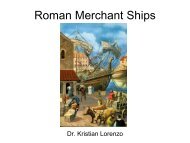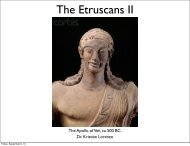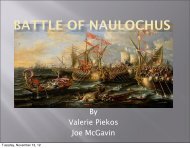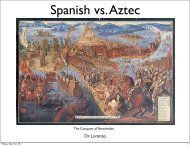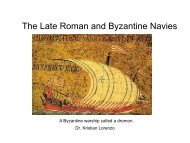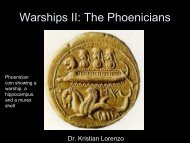World Mythology presents the major myths from around ... - Emmaf.org
World Mythology presents the major myths from around ... - Emmaf.org
World Mythology presents the major myths from around ... - Emmaf.org
You also want an ePaper? Increase the reach of your titles
YUMPU automatically turns print PDFs into web optimized ePapers that Google loves.
Preface-<br />
<strong>World</strong> <strong>Mythology</strong> <strong>presents</strong> <strong>the</strong> <strong>major</strong> <strong>myths</strong> <strong>from</strong> <strong>around</strong> <strong>the</strong> world in a manner<br />
that preserves <strong>the</strong>ir appeal as fineliterature. My retelling of each myth is based on<br />
scholarly English translations of <strong>the</strong> original material. 1 have retained <strong>the</strong> principal<br />
plot, characterization, style, and cultural values of <strong>the</strong> original, although a<br />
one-volume edition has made it necessary to shorten <strong>the</strong> longer epics. My goal,<br />
with <strong>the</strong>se shortened epics, has been to try to tell <strong>the</strong>m so well that readers will<br />
wish to go on to enjoy <strong>the</strong>m in a fine, unabridged translation.<br />
The <strong>myths</strong> are arranged geographically into seven <strong>major</strong> cultural groups: <strong>the</strong><br />
Middle East; Greece and Rome; <strong>the</strong> Far East and <strong>the</strong> Pacific Islands; <strong>the</strong> British<br />
Isles; Nor<strong>the</strong>rn Europe; Africa; and <strong>the</strong> Americas. In order to facilitate cross-cultural<br />
comparisons and contrasts, I have included creation, fertility, and hero<br />
<strong>myths</strong> <strong>from</strong> each culture. An introduction to each myth includes historical background,<br />
literary analysis, and an evaluation of <strong>the</strong> myth's appeal. Each myth is followed<br />
by interpretative questions. Notes at <strong>the</strong> end of <strong>World</strong> <strong>Mythology</strong> provide<br />
additional information about each myth, regarding my sources, selected supplementary<br />
sources, and, often, a wealth of additional information that will enhance<br />
critical study and fur<strong>the</strong>r reading pleasure.<br />
<strong>World</strong> <strong>Mythology</strong> reflects <strong>the</strong> fact that we live in an exciting and challenging<br />
time. We live in an exciting time because <strong>the</strong> world is becoming smaller. We are<br />
becoming more familiar with its diverse cultures and more aware of <strong>the</strong> many<br />
ways that <strong>the</strong>y have enriched each o<strong>the</strong>r through <strong>the</strong> centuries. This is reflected,<br />
in this new edition, in revised introductions and additional notes to our most<br />
cherished epics, introductions and notes that now reveal <strong>the</strong> cultural complexity<br />
of <strong>the</strong>se works—<strong>the</strong> ways in which, even when <strong>the</strong>y were written, <strong>the</strong>y reflected<br />
different cultures, both old and contemporary.<br />
We live in a challenging time because we recognize an ever-increasing need to<br />
view all members of <strong>the</strong> human family as related, and we need <strong>the</strong> knowledge and<br />
<strong>the</strong> experience that will help us to understand and respect each culture's unique<br />
contributions to our own life experience. The study of world mythology helps to<br />
give us this knowledge and this experience.<br />
<strong>World</strong> <strong>Mythology</strong> introduces you to stories that are among <strong>the</strong> greatest in <strong>the</strong><br />
history of <strong>the</strong> world. It is interesting that <strong>the</strong> people who created <strong>the</strong>se stories<br />
lived in all parts of <strong>the</strong> world. However, "interest" is not enough to unite all<br />
human beings into one great human family, because "interesting" is a word that<br />
describes <strong>the</strong> mind's reaction to something outside of itself. These <strong>myths</strong>—<strong>the</strong><br />
gteatest of stories—appeal to <strong>the</strong> human heart, and so <strong>the</strong>y arouse feelings within<br />
each reader. These <strong>myths</strong> involve emotion: anticipation, excitement, hope, love,<br />
dread, despair, sorrow, and empathy. The great <strong>myths</strong> belong to <strong>the</strong> listener as<br />
well as to <strong>the</strong> bard who recites <strong>the</strong>m. They belong to <strong>the</strong> reader as well as to <strong>the</strong><br />
poet who has written <strong>the</strong>m. Readers feel <strong>the</strong>se stories—<strong>the</strong>y quicken <strong>the</strong>ir pulse,<br />
and <strong>the</strong>y bring tears to <strong>the</strong>ir eyes. Readers think about <strong>the</strong>se stories—tonight <strong>the</strong>y<br />
invade <strong>the</strong>ir dreams, and tomorrow <strong>the</strong>y open a new world of experience, for <strong>the</strong>y<br />
have become pan of <strong>the</strong>ir readers' lives.<br />
Those who study world mythology find that <strong>the</strong>ir world has become both<br />
smaller and larger. Their world has become smaller because <strong>the</strong>y realize that.<strong>the</strong>y<br />
share <strong>the</strong> humanity of <strong>the</strong> people to whom <strong>the</strong>se <strong>myths</strong> belong, no matter where<br />
and when,<strong>the</strong>y have lived. Their world becomes larger because <strong>the</strong>y respect and<br />
appreciate cultures that <strong>the</strong>y never knew existed. It is in this way that readers come<br />
to know that human beings are remarkably alike through time and across space.<br />
Myths reflect human nature, with its needs and desires, hopes and fears.<br />
Myths teveal <strong>the</strong> human condition. Creation <strong>myths</strong> satisfy <strong>the</strong> need to have roots.<br />
Fertility <strong>myths</strong> respond to <strong>the</strong>-need for economic stability in an unpredictable<br />
world. Hero <strong>myths</strong>, provide models for human behavior. Myths reveal .cultural<br />
responses to <strong>the</strong> ever T important questions: Who am I? How should I lead my life?<br />
Thus, <strong>the</strong>y reveal <strong>the</strong> different, ways in which human beings respond to <strong>the</strong> issues<br />
that unite <strong>the</strong>m.<br />
The, study of comparative mythology leads readers to learn more about,<br />
<strong>the</strong>mselves as well as more about o<strong>the</strong>rs. By seeing <strong>the</strong> ways in which <strong>the</strong> characters<br />
in <strong>the</strong> great <strong>myths</strong> respond to <strong>the</strong> issues that confront <strong>the</strong>m, readers gain<br />
insight into <strong>the</strong>mselves and become able to evaluate <strong>the</strong> nature of <strong>the</strong>ir own lives.<br />
Like <strong>the</strong> heroes of every culture, all people today confront choices that force <strong>the</strong>m<br />
to reconcile <strong>the</strong>ir personal wishes with <strong>the</strong>ir responsibility to o<strong>the</strong>rs. Like <strong>the</strong>se<br />
heroic figures, all people today must confront tasks in <strong>the</strong> course of <strong>the</strong>ir daily<br />
lives that appear to be insurmountable. They, too, must be courageous and determined<br />
if <strong>the</strong>y are to achieve <strong>the</strong>ir goals. The study of <strong>the</strong> hero teaches that great<br />
character is as important as great deeds.<br />
The study of world mythology leads readers to broaden <strong>the</strong>ir knowledge,<br />
understanding, and appreciation of interrelationships. They learn that, <strong>from</strong> <strong>the</strong><br />
time of <strong>the</strong> earliest cities, through travel, trade, and talk, people have learned <strong>from</strong><br />
each o<strong>the</strong>r. Their technology has traveled, and <strong>the</strong>ir great stories—<strong>the</strong> <strong>myths</strong> and<br />
legends in <strong>the</strong>ir oral and written traditions—have traveled. In this way, for centuries,<br />
one culture has continued to enrich ano<strong>the</strong>r.<br />
The world's <strong>myths</strong> continue to inspire many creative and intellectual pursuits.<br />
They enrich <strong>the</strong> appreciation of literature, ,art, and music and can lead to<br />
greater interest in history, religion, psychology, anthropology, and archaeology.<br />
Myths symbolize human experience and embody <strong>the</strong> spiritual, values of a culture.<br />
Every society preserves its <strong>myths</strong>, because <strong>the</strong> beliefs and worldview found within<br />
<strong>the</strong>m are crucial to <strong>the</strong> survival of that culture. Myths usually originate in an<br />
ancient, oral tradition. Some explain origins, natural phenomena, and death; o<strong>the</strong>rs<br />
describe <strong>the</strong> nature and function of divinities; while stiII J o<strong>the</strong>rs provide models<br />
of virtuous behavior by relating <strong>the</strong> adventures of heroes or <strong>the</strong> misfortunes of<br />
arrogant humans. Myths often include elements <strong>from</strong> legend and folklore. They<br />
depict humans as an integral part of a, larger universe, and <strong>the</strong>y impart a feeling of<br />
awe for all that is mysterious and marvelous in life.<br />
Although most of <strong>the</strong> <strong>myths</strong> in <strong>World</strong> <strong>Mythology</strong> were created by people who<br />
lived in societies that were much less complex than our own, <strong>the</strong>y address fundamental<br />
questions that each thinking person continues to ask: Who am I? What is<br />
<strong>the</strong> nature of <strong>the</strong> universe in which I live? How, do I relate to that universe? How<br />
much control do I have over my own life? What must I do in order to survive?<br />
How can I lead a satisfying life? .How can I balance my own desires with my<br />
responsibilities to my family and my community?. How can I reconcile myself to<br />
<strong>the</strong> inevitability of death? Therefore, <strong>myths</strong> are an important way to understand<br />
ourselves. Because <strong>the</strong>y provide a variety of answers to <strong>the</strong>se questions, <strong>the</strong>y present<br />
us with new possibilities, and by considering <strong>the</strong>se possibilities, we gain<br />
insight into our own attitudes and values.<br />
Myths are also an important way to understand our connection to o<strong>the</strong>r people<br />
at a time when <strong>the</strong> welfare of each culture depends on <strong>the</strong> attitudes and<br />
actions of o<strong>the</strong>r cultures. The answers to <strong>the</strong>se questions have produced a body of<br />
<strong>myths</strong> <strong>from</strong> diverse cultures that closely resemble each o<strong>the</strong>r in subject, although<br />
<strong>the</strong> treatment of each issue naturally varies <strong>from</strong> one society to ano<strong>the</strong>r. Despite<br />
<strong>the</strong> unique perspective of each culture.<strong>the</strong>ir shared concerns tie human beings to<br />
one ano<strong>the</strong>r across <strong>the</strong> globe and throughout history.<br />
Moreover, <strong>the</strong>ir shared concerns performed this function in ancient times as<br />
well as in our own day. What has largely gone unnoticed is <strong>the</strong> mobility of oral,<br />
and even written, literature in ancient times and <strong>the</strong> cultural influence that one<br />
ancient culture had on ano<strong>the</strong>r.' The great epics cry out to be told, and so <strong>the</strong>y<br />
traveled <strong>the</strong> seaways with merchants, sailors, visitors, warriors, immigrants, scholars,<br />
and professional entertainers who were part historian and part storyteller.<br />
Particularly If <strong>the</strong>y lived in a colony, in an empire, or near <strong>major</strong> trade routes,<br />
xii £ ~*' P r e t a c e<br />
«"•> xiii
professionally trained bards knew and performed <strong>the</strong> literature of o<strong>the</strong>r cultures,<br />
as well as <strong>the</strong>ir own. This process not only preserved <strong>the</strong> greatest <strong>myths</strong>—<strong>the</strong> epics<br />
of any culture—but it made it possible for <strong>the</strong> most skilled of bards and poets to<br />
enhance <strong>the</strong>ir own renditions, both oral and written, of <strong>the</strong>ir own culture s epics<br />
by creatively adapting <strong>the</strong> appealing aspects of <strong>the</strong> epics <strong>from</strong> o<strong>the</strong>r cultures, such<br />
as particular relationships between pairs of characters, important <strong>the</strong>mes, and<br />
artistic style.<br />
All too often, centuries later, a culture has considered its <strong>myths</strong>, with pride,<br />
to be totally homegrown. Yet <strong>the</strong> warriors as well as <strong>the</strong> historians of ancient<br />
Greece and Rome-were interested in <strong>the</strong> ethnology of foreign peoples, and <strong>the</strong>y<br />
recorded what <strong>the</strong>y learned, ei<strong>the</strong>r firsthand or <strong>from</strong> o<strong>the</strong>r sources. Their surviving<br />
histories and,essays reveal that <strong>the</strong> world's greatest epics,reflect <strong>the</strong> cultural<br />
influence of peoples who preceded <strong>the</strong>m by hundreds and even thousands of<br />
years. Moreover, archaeologists in <strong>the</strong> twentieth century have unear<strong>the</strong>d' thousands<br />
of clay tablets and opened many tombs that help us understand ancient<br />
cross-cultural connections. Revised introductions in this book to The Iliad and<br />
Beowulfrcilect what scholars, both old and new, have learned about <strong>the</strong> cultures<br />
that influenced <strong>the</strong> authors of <strong>the</strong>se epics and <strong>the</strong>ir orally transmitted material.<br />
In part because human beings are all part of one family, and in part because<br />
of cross-cultural contacts, <strong>the</strong> following <strong>the</strong>mes ate common in world mythology:<br />
The fitst parents are often <strong>the</strong> gods of sky and earth. The creator-god usually fashions<br />
<strong>the</strong> first human beings <strong>from</strong> parts of <strong>the</strong> earth—perhaps clay, trees, rocks, or<br />
plants. The gods destroy at least one world of mortals by causing a great flood. In<br />
<strong>the</strong> world, as in nature, birth, maturity, and death are often followed by rebirth.<br />
Heroes are children of gods who have an unusual birth,. possess extraordinary<br />
strength, kill monsters with <strong>the</strong> help of special weapons, embark on an arduous<br />
journey, descend into <strong>the</strong> Underworld as part of <strong>the</strong>ir tasks, and have an unusual<br />
death.<br />
An inherent part of many <strong>myths</strong> is <strong>the</strong> belief in one or more divine powers<br />
who create life and control,<strong>the</strong> direction of <strong>the</strong> universe. Throughout <strong>the</strong> world,<br />
<strong>the</strong>se divinities, whe<strong>the</strong>r in human or in animal form, are anthropomorphic in<br />
that <strong>the</strong>y think, act, and speak like human beings. They differ primarily in <strong>the</strong>ir<br />
! attitude toward mortals. Some gods, like those of Gteece, Egypt, India, and<br />
North America, appreciate <strong>the</strong> merits of human beings, are sympa<strong>the</strong>tic to <strong>the</strong>m,<br />
and try to help <strong>the</strong>m. O<strong>the</strong>t.gods, like those of Sumer,- Babylonia, and nor<strong>the</strong>rn<br />
Europe (<strong>the</strong> Norse gods), tend to be indifferent to <strong>the</strong> fate of human beings. Stillo<strong>the</strong>rs,<br />
like Sedna, <strong>from</strong>, <strong>the</strong> Inuit people of North America, are unpredictable,<br />
and <strong>the</strong>ir people must take constant care so as not to offend <strong>the</strong>m.<br />
Where an oral myth has been told to, and written down by, an outsider, <strong>the</strong><br />
au<strong>the</strong>nticity of <strong>the</strong> myth can be clouded by <strong>the</strong> teller's distortions or <strong>the</strong> outsider's<br />
biases. The <strong>myths</strong> <strong>from</strong> <strong>the</strong> Middle East, Greece arid Rome, and, to some extent,<br />
China and Japan have retained <strong>the</strong>ir au<strong>the</strong>nticity because <strong>the</strong>y were written down<br />
by people within <strong>the</strong> culture for. <strong>the</strong>ir own use..In o<strong>the</strong>r cultures, like those of<br />
India and China, <strong>the</strong> <strong>myths</strong> of earlier peoples were transcribed By people who<br />
intentionally imposed <strong>the</strong>ir own values on <strong>the</strong>m, and it is sometimes possible to<br />
discern <strong>the</strong> original form of <strong>the</strong> myth.<br />
However, in most cultures, like those of <strong>the</strong> Americas, Africa, and Ireland, <strong>the</strong><br />
<strong>myths</strong> were part of an oral tradition that, of necessity, was communicated by <strong>the</strong><br />
historian, through an interpreter, to a missionary or an anthropologist. Therefore,<br />
<strong>the</strong> au<strong>the</strong>nticity of <strong>the</strong>se <strong>myths</strong> depends on <strong>the</strong> motivation and <strong>the</strong> objectivity of<br />
three different * parties. In some cultures, <strong>the</strong> historian was not.permitted to reveal<br />
sacred material to an outsider (even <strong>the</strong> uninitiated in his own society). In o<strong>the</strong>r<br />
cultures, consciously or unconsciously, <strong>the</strong> outsiders were uncomfortable with<br />
pagan beliefs and values, and <strong>the</strong>y intentionally or inadvertendy changed what<br />
<strong>the</strong>y heard so that it conformed with <strong>the</strong>it own attitudes and values.<br />
THE PURPOSE OF M Y T H S<br />
Myths were originally created as entertaining stories with a serious purpose. Their<br />
broad appeal has enabled <strong>the</strong>m to survive for hundreds and sometimes thousands of<br />
years. A myth's serious purpose is ei<strong>the</strong>r to explain <strong>the</strong> nature of <strong>the</strong> universe (creation<br />
and fertility <strong>myths</strong>) or to instruct members of <strong>the</strong> community in <strong>the</strong> attitudes<br />
and behavior necessary to function successfully in that particular culture (hero<br />
<strong>myths</strong> and epics). The Hittite myth of Telepinu, <strong>the</strong> Ainu epic Kotan Utunnai, <strong>the</strong><br />
Micmac myth "Caught by a Hairstring," and <strong>the</strong> Yekuhana myth of Wanadi permit<br />
<strong>the</strong> reader to enter <strong>the</strong> wotld of a different culture and to see that world in a way<br />
that conveys <strong>the</strong> mystery of <strong>the</strong> universe and <strong>the</strong> fragility of human life.<br />
A particular, culture may be interested in <strong>the</strong> creation of <strong>the</strong> entire, universe,<br />
beginning with divine beings who separate earth and sky. Many cultures start<br />
with <strong>the</strong> beginning of <strong>the</strong> universe—a chaotic, formless mass that a god separates,<br />
as do Bumba in <strong>the</strong> Boshongo and Bakuba myth <strong>from</strong> Africa and P'an 'Ku in <strong>the</strong><br />
myth <strong>from</strong> China. In o<strong>the</strong>r cultures, like <strong>the</strong> Babylonian, <strong>the</strong> Greek, <strong>the</strong> Maori:<br />
<strong>from</strong> New Zealand, <strong>the</strong> Toltec/Aztec <strong>from</strong> Mexico, and <strong>the</strong> Maya <strong>from</strong><br />
Guatemala, <strong>the</strong> universe begins with a group of two or more gods, who multiply<br />
so that each can have his ot her particular role in <strong>the</strong> universal scheme. In still<br />
o<strong>the</strong>r cultures, a creator-god, like Wanadi in <strong>the</strong> Yekuhana myth <strong>from</strong> Venezuela<br />
or Viracocha in <strong>the</strong> Tiahuanaco/Aymara myth <strong>from</strong> Peru,' brings life to earth in<br />
<strong>the</strong> form of plants, animals, and human beings.<br />
In contrast, some cultures are interested in <strong>myths</strong> that explain <strong>the</strong> origin of<br />
<strong>the</strong>ir own people and enhance <strong>the</strong>ir nationalistic spirit. For example, <strong>the</strong> Navajo<br />
people depict <strong>the</strong>ir journey upward through four worlds into a fifth world.<br />
Similarly, <strong>the</strong> Irish Celts are concerned with <strong>the</strong> settling .of Ireland, and <strong>the</strong><br />
Yoruba people explain <strong>the</strong> creation of Ife, <strong>the</strong>ir sacred city-state.<br />
The <strong>myths</strong> of o<strong>the</strong>r cultures explain <strong>the</strong> continued existence of evil in <strong>the</strong><br />
universe. Myths like Wanadi <strong>from</strong> <strong>the</strong> Yekuhana-people of Venezuela, Esfandyar<br />
r '*><br />
Introduction<br />
Introduction<br />
^*>xv
H<br />
<strong>from</strong> Persia, "Quetzalcoatl" <strong>from</strong> Toltec/Aztec people of Mexico, and "The<br />
Woman Who Fell <strong>from</strong> <strong>the</strong> Sky" <strong>from</strong> <strong>the</strong> Iroquois/Huron people of <strong>the</strong> United<br />
States and Canada depict a universe in which a good divinity and an evil divinity<br />
wage constant war on earth for„<strong>the</strong> human soul.<br />
According to many <strong>myths</strong>, human beings are not perfect creatures even<br />
though a god created <strong>the</strong>m. In many cultures, .<strong>the</strong> creator-god must fashion'and<br />
destroy, usually through a flood; a succession of races. This <strong>the</strong>me is found worldwide,<br />
<strong>from</strong> <strong>the</strong>.Hindu <strong>myths</strong> of India to <strong>the</strong> <strong>myths</strong> of <strong>the</strong> Maya of Central<br />
America and <strong>the</strong> Yoruba <strong>myths</strong> of Africa. One of <strong>the</strong> most elaborate flood <strong>myths</strong><br />
comes <strong>from</strong> Sumer and Babylonia.<br />
All. cultures explain howvhuman beings acquired particular foods and <strong>the</strong><br />
agricultural tools that permitted <strong>the</strong>m to become civilized. Some <strong>myths</strong>, like <strong>the</strong><br />
Hittite myth of Telepinu, <strong>the</strong> Japanese myth of Amaterasu, and <strong>the</strong> African myth<br />
<strong>from</strong> Dahomey, involve gods who have been insulted and must be appeased for<br />
fertility to be restored. The Telepinu myth includes powerful metaphorical incantations<br />
designed to enlist <strong>the</strong> god's aid. The Greek myth of Demeter and<br />
Persephone is a masterpiece of psychological complexity.<br />
The <strong>myths</strong> of o<strong>the</strong>r cultures involve a divine figure who teaches agricultural<br />
skills to human beings. Viracocha introduces <strong>the</strong> Aymara/Tiahuanaco people to a<br />
more complex and civilized way of life, just as Wanadi does for <strong>the</strong> Yekuhana<br />
people and Quetzalcoatl does for <strong>the</strong> Toltec people. O<strong>the</strong>r <strong>myths</strong>; like <strong>the</strong><br />
Chinese myth of Chi Li, show a heroic figure rescuing humanity by killing a<br />
monstet that has destroyed <strong>the</strong> fertility of <strong>the</strong> land: Similarly, in <strong>the</strong> Hawaiian<br />
myth, Maui tames <strong>the</strong> sun so that his people will have more light in which to pursue<br />
<strong>the</strong> activities that are necessary for <strong>the</strong>ir survival. The <strong>myths</strong> of many people<br />
involve trickster twins, such as Lodge-Boy and Thrown-Away <strong>from</strong> <strong>the</strong> Crow people<br />
in <strong>the</strong> United States, who kill monsters and so make <strong>the</strong> wotld safe for <strong>the</strong>ir<br />
people.<br />
The heroic; <strong>myths</strong> and epics of a society teach its members <strong>the</strong> appropriate<br />
attitudes, behavior, and values of that culture. These <strong>myths</strong> are of particular interest<br />
and value to us., Not only-are <strong>the</strong>y exciting adventure stories, but in <strong>the</strong>se<br />
<strong>myths</strong> we see ourselves, drawn • larger and grander than we are, yet with our<br />
human weaknesses as well as our strengths. h<br />
Heroes are <strong>the</strong> models of human behavior foi <strong>the</strong>ir society. They earn lasting<br />
fame—<strong>the</strong> only kind of immortality possible for .1 tuman beings—by performing<br />
great deeds that help <strong>the</strong>ir community, and <strong>the</strong>y inspire o<strong>the</strong>rs to emulate <strong>the</strong>m.<br />
Heroes are forced by circumstance to make critica choices where <strong>the</strong>y must balance<br />
one set of values against, competing values. j,'hey achieve heroic stature in<br />
part <strong>from</strong> <strong>the</strong>ir accomplishments and in patt beca' se <strong>the</strong>y emerge <strong>from</strong> <strong>the</strong>ir trials<br />
as more sensitive and thoughtful human beings'<br />
Yet heroes are not <strong>the</strong> same throughout th world. Achilles, Gilgamesh,<br />
Heracles, Jason, <strong>the</strong> young Beowulf, Sigurd thf •Volsung, <strong>the</strong> hero of Kotan<br />
Utunnai, and Bakaridjan Kone, for example, come irom cultures where individuals<br />
may earn fame in a variety of ways. This permits <strong>the</strong>m to express <strong>the</strong>ir individuality.'<br />
In contrast, Rama must always remember and follow dharma, <strong>the</strong> particular form<br />
of proper and righteous behavior that <strong>the</strong> Hindu culture expects of a person in his<br />
or her political, economic, and social position. Esfandyar must remain true to <strong>the</strong><br />
principles of his religion, Zoroastriariism. Aeneas must always act in a way-that is<br />
compatible with his god-given destiny. Arthur must keep <strong>the</strong> knights of <strong>the</strong> Round<br />
Table in harmony with one ano<strong>the</strong>r and with him for <strong>the</strong> good of Britain, and in his<br />
old age, Beowulf, as <strong>the</strong> war-king of <strong>the</strong> Geats, must protect his people by fighting<br />
a dragon that is destroying his country.<br />
In spite of <strong>the</strong>ir extf aordinary abilities, no 'hero is perfect. Yet <strong>the</strong>ir human<br />
weaknesses are often as instructive as <strong>the</strong>ir heroic qualities. Their imperfections<br />
allow ordinary people to identify with <strong>the</strong>m and to like <strong>the</strong>m, for everyone has<br />
similar psychological needs and conflicts.<br />
Many of <strong>the</strong> gteatest heroes cannot accept mortality. Gilgamesh so fears<br />
death that he undertakes a long and perilous journey in search of <strong>the</strong> secret of<br />
immortality. Ultimately, he learns to be satisfied with <strong>the</strong> immortality that comes<br />
<strong>from</strong> enduring accomplishments. Achilles much choose between death with<br />
honor and a long, undistinguished life. When he* feels deprived of honor on <strong>the</strong><br />
battlefield, he chooses life, and only <strong>the</strong> unforeseen ramifications of that choice<br />
cause him to change his mind. Hector and Beowulf are forced to choose heroic<br />
deaths because <strong>the</strong>y cannot live with <strong>the</strong> stain of cowardice.<br />
Unlike most heroes, Heracles knows that he will become immortal after he<br />
has accomplished his labots. His primary concern is to avoid <strong>the</strong> labors because he<br />
refuses to be controlled by a cowardly king. In contrast, <strong>the</strong> immortality of lasting<br />
fame is so important to Gassire that he will do anything to achieve it, even if it<br />
destroys his people. Bakaridjan Kone must confront his loss of fame and decide<br />
what he is willing to do in order to regain it. Jason is so impressed with his<br />
fame that he feels entitled to act as he wishes, with' no serious thought about <strong>the</strong><br />
consequences.<br />
The hero <strong>myths</strong> examine <strong>the</strong> relationship between <strong>the</strong> individual's desires<br />
and his or her responsibilities to society. Often" <strong>the</strong> choice is crucial but uncomplicated:<br />
whe<strong>the</strong>r or not to risk death to save <strong>the</strong> community. The hero who<br />
chooses to risk'death acquires honor and lasting fame; <strong>the</strong> hero who chooses<br />
safety is denied both. Esfandyar, Heracles, Beowulf, and Chi Li make <strong>the</strong> world~a<br />
safer place by killing many monsters. The hero of Kotan Utunnai helps his people<br />
by fighting valiantly against <strong>the</strong> enemy.<br />
In <strong>the</strong> <strong>major</strong> epics, <strong>the</strong> issue is <strong>the</strong> same, but <strong>the</strong> circumstances are infinitely<br />
more complex. When a leader places his or her own desires before <strong>the</strong> needs of <strong>the</strong><br />
community, both <strong>the</strong> community and <strong>the</strong> individual suffer. Agamemnon and<br />
Achilles quarrel over a slave girl because public honor is <strong>the</strong> key to self-esteem.<br />
Similarly, Lancelot and Guinevere place <strong>the</strong>ir love above <strong>the</strong>ir loyalty to King<br />
Arthur, <strong>the</strong>reby destroying <strong>the</strong> Round Table and putting Britain into <strong>the</strong> hands of<br />
powet-hungry local rulers. Aeneas places <strong>the</strong> needs of his community above his<br />
xvi c-+? Introduction<br />
Introduction < r *> xvii
personal desires but loses his own humanity. Similarly, Rama places <strong>the</strong> needs of<br />
his community above his love for Sita, causing great personal tragedy for both of<br />
<strong>the</strong>m. On <strong>the</strong> o<strong>the</strong>r, hand, Gassire earns fame by placing his personal desires<br />
before <strong>the</strong> needs of his community, and Jason loses fame for <strong>the</strong> same reason.<br />
Bakaridjan Kone's community supports his heroism even though it is at <strong>the</strong>,<br />
expense of an innocent community.<br />
Heroes define <strong>the</strong>mselves by.how <strong>the</strong>y relate to external circumstances. They<br />
acquire lasting fame by performing deeds of valor, but <strong>the</strong>y acquire even greater<br />
heroic stature by winning an inner battle against <strong>the</strong>ir desires. Hector Lfights a<br />
greater battle because he first must overcome his fear of Achilles. Both he and<br />
Beowulf fight against a superior foe, knowing that <strong>the</strong>y will die.in <strong>the</strong> process yet<br />
choosing to die with honor ra<strong>the</strong>r than to live without'.self-esteem and public<br />
approval. In contrast, Quetzalcoatl is outmatched whenTezcatlipoca preys upon<br />
his vanity, and Jason is destroyed when his vanity leads him to dishonor Medea,<br />
his wife and benefactor.<br />
We should.not be. intimidated by <strong>the</strong> external characteristics of <strong>the</strong> hero: an<br />
immortal parent, unusual birth, aristoctatic social position, and divine sponsorship.<br />
We could say that Heracles can perform great tasks because his fa<strong>the</strong>r is<br />
Zeus. We do this; in our own lives whenever we attribute someone's success primarily<br />
to luck instead" ^of to individual courage, perseverance, and ability.<br />
However, this attitude is not personally helpful. Although <strong>the</strong>se heroes lived long<br />
ago in cultures very different <strong>from</strong> our own, <strong>the</strong>y can still serve as models fot us.<br />
We,too,must,often risk our self-esteem and our reputation by making difficult<br />
choices and by attempting tasks where we fear failure. We top want to live in such<br />
as way that we are remembered for our good deeds.<br />
THE M A T R I A R C H A L<br />
SOCIETY<br />
A knowledge of <strong>the</strong> basic difference between Mo<strong>the</strong>r Earth—centered matriarchal<br />
religions and .<strong>the</strong>. Fa<strong>the</strong>r Sky-centered patriarchal religions is crucial to an understanding<br />
of <strong>the</strong> symbolic content of many <strong>myths</strong>. The political, economic, social,<br />
and religious foundation of <strong>the</strong> matriarchal society was <strong>the</strong> agricultural, year. The<br />
importance of agriculture fostered a cyclical view of life, emphasizing <strong>the</strong> progression<br />
of all living matter <strong>from</strong> birth jo maturity to death to rebirth. Even in lands<br />
where <strong>the</strong> climate remained relatively stable <strong>from</strong> one season to <strong>the</strong> next, people<br />
could see <strong>the</strong> connection between <strong>the</strong> development of <strong>the</strong>ir own lives and <strong>the</strong><br />
development of life among plants and animals;<br />
In <strong>the</strong> matriarchal society, <strong>the</strong> Great Goddess or Mo<strong>the</strong>r Goddess personified<br />
Mo<strong>the</strong>r Earth and.was <strong>the</strong> supreme deity. She functioned in three related forms.<br />
As Goddess of <strong>the</strong> Underworld, she controlled <strong>the</strong> three-stage cycle of life: <strong>the</strong><br />
period of birth and childhood; <strong>the</strong> fertile, period of maturity and reproduction;<br />
and <strong>the</strong> sterile period of old age, with its. decline and death.<br />
Goddess of <strong>the</strong> Earth, she controlled <strong>the</strong> three-stage cycle of <strong>the</strong> seasons:<br />
spring—<strong>the</strong> period of birth or rebirth, and budding growth; summer—<strong>the</strong> fertile<br />
period of blossoming and harvest; and winter—<strong>the</strong> sterile period of decay, barrenness,<br />
and death ordotmancy.<br />
As Goddess of <strong>the</strong> Sky, she was <strong>the</strong> great Moon Goddess, who appeared in,<br />
her three-stage cycle of phases: as <strong>the</strong> new and waxing moon—<strong>the</strong> period of birth<br />
or rebirth, and growth; as <strong>the</strong> full moon—<strong>the</strong> period of maturity; and as <strong>the</strong> waning<br />
moon—<strong>the</strong> period of decline and death ot dormancy.<br />
Consequently, <strong>the</strong> Great Goddess was <strong>the</strong> soutce of all human life and <strong>the</strong>"<br />
source of all food. To survive, societies needed to produce children and to produce<br />
food. They knew how dependent <strong>the</strong>y were upon <strong>the</strong> blessings of <strong>the</strong> Great<br />
Goddess, and <strong>the</strong>y worshipped her properly so <strong>the</strong>y would receive those blessings.<br />
The -queen #embodied <strong>the</strong> spirit <strong>the</strong> Great Goddess, and she wielded great<br />
political, economic, social, and religious power. O<strong>the</strong>r women were considered<br />
daughters of <strong>the</strong> Great Goddess. Thus, all women in <strong>the</strong> matriarchal society were<br />
highly valued, and many of <strong>the</strong>m held important positions. Women were <strong>the</strong><br />
heads of <strong>the</strong>ir families, and inheritance passed <strong>from</strong> a mo<strong>the</strong>r to her daughters,<br />
with <strong>the</strong> youngest daughter being most important because, presumably, she<br />
would be <strong>the</strong> last to die and thus would continue <strong>the</strong> family line <strong>the</strong> longest.<br />
Children were reared by <strong>the</strong>ir mo<strong>the</strong>r and her bro<strong>the</strong>r, while <strong>the</strong> fa<strong>the</strong>r lived in<br />
<strong>the</strong> home of his mo<strong>the</strong>r and helped rear.his sisters children. The children's primary<br />
moral obligations were to <strong>the</strong>ir mo<strong>the</strong>r and <strong>the</strong>ir siblings.<br />
When <strong>the</strong> male's role in procreation became understood and valued, <strong>the</strong><br />
queen took a husband, called <strong>the</strong> sacred king, for one year. At first, he was her<br />
bro<strong>the</strong>r or her son, but later he was a youth who symbolized her son. Many<br />
youths competed for <strong>the</strong> great honor of being sacred king. They had'towih many<br />
contests involving physical strength and <strong>the</strong> skillful use of <strong>the</strong> bow. Heracles' tasks<br />
against <strong>the</strong> Nemean lion, <strong>the</strong> Cretan bull, <strong>the</strong> Erymanthian boar, and Artemis's<br />
deer represent typical contests. Odysseus's participation in an archery contest<br />
where <strong>the</strong> winner will marry Penelope is an echo of this tradition.<br />
Each spring, when <strong>the</strong> seeds of <strong>the</strong> new crops were sown, <strong>the</strong> past years<br />
sacred king would be sacrificed as part of a <strong>major</strong> religious ceremony. The priestesses<br />
of <strong>the</strong> Mo<strong>the</strong>r Goddess would eat his flesh in order to acquire his powers of<br />
fertility, and <strong>the</strong> fields and farm animals would be sprinkled with his blood so<br />
<strong>the</strong>y too would become fertile. Then, in a religious ceremony, <strong>the</strong> queen would<br />
take a new sacred king for <strong>the</strong> coming year.<br />
The sacred king gradually gained more power. He increased <strong>the</strong> length of his<br />
reign to eight years by choosing a substitute, or surrogate, sacred king to die in his<br />
place. At <strong>the</strong> end of each year, <strong>the</strong> real king would retire <strong>from</strong> public view into a<br />
burial chamber or cave for one to three days, while <strong>the</strong>-surrogate sacred king<br />
reigned in his place. The priestesses of <strong>the</strong> Great Goddess would sacrifice <strong>the</strong> surrogate<br />
king in a sacred ceremony and use his flesh and blood to ensure <strong>the</strong> fertility<br />
of <strong>the</strong> community. Then <strong>the</strong> real king would resume his duties for <strong>the</strong> coming year.<br />
As<br />
xvm
When Gilgamesh rejects Ishtars marriage proposal, he related <strong>the</strong> ways that<br />
she has destroyed previous mates. Ishtar retaliates by causing <strong>the</strong> death of Enkidu,<br />
who functions as Gilgamesh's surrogate. Demeter in Greek culture and Amaterasu<br />
in Japanese culture are examples of <strong>the</strong> Great Goddess. Moreover, vestiges of <strong>the</strong><br />
pre-Hellenic matriarchal culture remain in <strong>the</strong> Greek <strong>myths</strong> of Jason, Medea,<br />
Heracles, Achilles, and Paris.<br />
By 2400 B.C., aggressive tribes worshipping a supreme male god who was a<br />
fa<strong>the</strong>r-figure or a successful warrior had begun to invade many matriarchal communities.<br />
They brought with <strong>the</strong>m a new social and political order in which males dominated.<br />
Kings gained enough power to change <strong>the</strong> old social system to one in which<br />
kings ruled by heredity and animals were sacrificed to win <strong>the</strong> favor of <strong>the</strong> gods.<br />
Some cultures depict a world view in which one generation of gods replaces<br />
ano<strong>the</strong>r, <strong>the</strong> newer gods being more civilized and capable than <strong>the</strong> earlier ones.<br />
For example, Zeus conquers Cronus in. Greek mythology, and Marduk conquers<br />
Tiamat in Babylonian mythology. The battle between one family of gods and<br />
ano<strong>the</strong>r often reflects <strong>the</strong> political and religious conflict between <strong>the</strong> indigenous<br />
people, who were farmers and worshipped <strong>the</strong> Great Goddess or <strong>the</strong> Mo<strong>the</strong>r<br />
Goddess, and a warlike invading people, who worshipped.male sky gods. Zeus's<br />
conquest of Cronus and <strong>the</strong> Titans reflects <strong>the</strong> political conquest of one people by<br />
ano<strong>the</strong>r, and his liaisons with many Mo<strong>the</strong>r Goddesses in addition^to Hera, his<br />
wife, represent a compromise in which <strong>the</strong> invader's religion was united with each<br />
local religion. Similar .changes are reflected in Babylonian mythology, where a religion<br />
in which Marduk is <strong>the</strong> principal god incorporates <strong>the</strong> older gods.<br />
ACADEMIC PERSPECTIVES O N M Y T H S<br />
Because <strong>myths</strong> are symbols of human experience, <strong>the</strong>y can be analyzed in a variety<br />
of ways, depending upon <strong>the</strong> perspective of <strong>the</strong> scholar. Years ago, many scholars<br />
viewed <strong>myths</strong> as symbols of <strong>the</strong> external environment. Those who crated <strong>myths</strong><br />
were thought to have observed nature and interpreted <strong>the</strong> behavior of human beings<br />
in a parallel manner. For example, heroes were considered symbols of <strong>the</strong> sun. They<br />
wielded swords that symbolized <strong>the</strong> sun's rays against monsters that symbolized<br />
clouds and night, <strong>the</strong> enemies of <strong>the</strong> sun. Each hero story was thus a symbol of <strong>the</strong><br />
conflict between day and night and, by extension, between good and evil.<br />
In <strong>the</strong> twentieth century, <strong>the</strong> symbolic interpretation of <strong>myths</strong> moved <strong>from</strong><br />
<strong>the</strong> external environment to <strong>the</strong> internal environment of <strong>the</strong> unconscious mind.<br />
Sigmund Freud and his followers view <strong>myths</strong> as <strong>the</strong> expression of <strong>the</strong> individuals<br />
unconscious wishes, fears, and drives. For example, Otto Rank explains <strong>the</strong> characteristics<br />
of <strong>the</strong> traditional hero in terms of infantile hostility, childhood fantasies,<br />
and rebellion against one's fa<strong>the</strong>r.<br />
Carl Jung and his followers, among -<strong>the</strong>m Carl Kerenyi, Erich Neumann,<br />
and, more broadly, Joseph Campbell, view <strong>myths</strong> as <strong>the</strong> expression of a universal,<br />
collective unconscious. In <strong>the</strong>ir <strong>the</strong>ory, innate psychological characteristics, common<br />
to all human beings, determine how people throughout <strong>the</strong> world and<br />
throughout history experience and respond to <strong>the</strong> process of living. The contents<br />
of <strong>the</strong> collective unconscious are divided into archetypes—such as <strong>the</strong> mo<strong>the</strong>r, <strong>the</strong><br />
child, <strong>the</strong> hero, <strong>the</strong> trickster, and <strong>the</strong> giant— : but <strong>the</strong>se are simply image frameworks.<br />
A particular individual's life experiences determine in what particular<br />
shape and form <strong>the</strong> archetypal images will be expressed. Thus, <strong>the</strong> fact that <strong>myths</strong><br />
<strong>from</strong> <strong>around</strong> <strong>the</strong> world contain many similar <strong>the</strong>mes reflects <strong>the</strong> existence of a<br />
common collective unconscious. The fact that <strong>the</strong>y differ in <strong>the</strong>ir treatment of<br />
<strong>the</strong>se <strong>the</strong>mes reflects <strong>the</strong> influence of each culture's particular physical, social, economic,<br />
and political environment on <strong>the</strong> archetypes.<br />
Scholars in this century have interpreted <strong>myths</strong> in o<strong>the</strong>r ways as well. Mircea<br />
Eliade, a historian of religions, views <strong>myths</strong> as <strong>the</strong> essence of religion, conceived<br />
<strong>from</strong> a genuine religious experience. It is <strong>the</strong> sacred experience that gives <strong>myths</strong><br />
<strong>the</strong>ir structure and <strong>the</strong>ir utility. The ancient world contained a multitude of coexisting<br />
religious ideas and forms: different types of mono<strong>the</strong>ism and poly<strong>the</strong>ism<br />
(both female-dominated and male-dominated), nature worship, and ancestor<br />
worship. Consequently, numerous similarities and connections exist <strong>from</strong> one<br />
culture to ano<strong>the</strong>r. This is evident <strong>from</strong> <strong>the</strong> study of various aspects of <strong>the</strong> religious<br />
experience, such as <strong>the</strong> nature of divinities, creation <strong>myths</strong>, sacrifices, rituals,<br />
death, and paradise.<br />
The anthropologist Paul Radin views <strong>myths</strong> <strong>from</strong> an economic perspective.<br />
The individuals actual struggle for survival in <strong>the</strong> face of economic uncertainty,<br />
caused by an insufficient food supply and poor technology, creates fears that life<br />
will be unhappy and short. Religious leaders manipulate <strong>the</strong>se fears for <strong>the</strong>ir own<br />
material benefit, often in concert with <strong>the</strong> political leaders of <strong>the</strong> community.<br />
The anthropologist Claude Levi-Strauss views <strong>myths</strong> as abstract constructions<br />
ra<strong>the</strong>r than narrative tales or symbols of experience. The structure of all<br />
human minds is identical and is revealed by <strong>the</strong> similar ways people solve <strong>the</strong>ir<br />
problems. Myths are identical products <strong>from</strong> identical minds, so <strong>myths</strong> <strong>from</strong><br />
<strong>around</strong> <strong>the</strong> world possess a common structure. They reveal <strong>the</strong> conflict between<br />
opposing forces—such as life and death or nature and culture. To discover <strong>the</strong><br />
meaning of a particular myth, one must focus on its underlying structure ra<strong>the</strong>r<br />
than its narrative content or any symbolic meaning. This structure invariably<br />
reveals tensions in social relations or economic problems. The analysis of <strong>myths</strong><br />
proves that human beings, no matter how primitive <strong>the</strong>ir technology, are not<br />
mentally inferior. Their <strong>myths</strong> demonstrate that <strong>the</strong>y possess <strong>the</strong> intellectual<br />
capacity to understand <strong>the</strong> world in which <strong>the</strong>y live.<br />
Part of <strong>the</strong> fascination of mythology involves viewing it <strong>from</strong> a variety of perspectives<br />
simultaneously. Each discipline offers a valuable contribution, increasing<br />
our appreciation of <strong>the</strong> whole.<br />
e<br />
^<br />
xx Intro.ductio<br />
Introduction<br />
^ xxi





